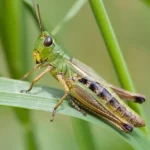
The Philippine Eagle, a majestic and critically endangered bird, holds a significant place in both the natural world and Filipino culture. Renowned for its impressive size, unique appearance, and powerful vocalizations, this eagle is a symbol of strength and pride in the Philippines. Despite its grandeur, the Philippine Eagle faces severe conservation challenges, prompting international attention and dedicated efforts to ensure its survival. Here are some intriguing and verified facts about the Philippine Eagle that highlight its cultural importance, distinctive features, and the ongoing conservation efforts to protect this remarkable species.
Scientific Name: The Philippine Eagle is scientifically classified as Pithecophaga jefferyi. This name honors the American ornithologist and naturalist John Jeffrey, who contributed to the study of birds in the Philippines. The genus name Pithecophaga derives from Greek, meaning “monkey-eating,” which reflects its diet that often includes primates, particularly the Philippine tarsier. The species name jefferyi acknowledges the contributions of Jeffrey to ornithology.
National Bird: In 1995, the Philippine Eagle was officially declared the national bird of the Philippines through Republic Act No. 8492. This designation highlights its significance as a symbol of national pride and identity. The designation also aims to raise awareness about the conservation needs of this critically endangered species, which is a testament to the Philippines’ rich biodiversity. The eagle’s status as a national symbol emphasizes the importance of protecting the natural heritage of the country.
Endemic Species: The Philippine Eagle is an endemic species, meaning it is native to the Philippines and does not occur naturally anywhere else in the world. This unique status contributes to its ecological significance, as it plays a crucial role in the ecosystems of the islands it inhabits. The eagle’s presence indicates a healthy forest ecosystem, as it is at the top of the food chain. The loss of this species would not only diminish biodiversity but also disrupt the ecological balance within its habitat.
Habitat: The Philippine Eagle primarily inhabits the rainforests of the Philippines, thriving in dense, mature forests that provide ample food and nesting sites. Its range includes the islands of Luzon, Leyte, Mindanao, and Samar, where it prefers elevations between 1,000 to 2,000 meters (3,280 to 6,560 feet). The eagle relies on large trees for nesting and hunting, making deforestation a significant threat to its habitat. The loss of these forests due to logging, agriculture, and urbanization poses a critical challenge to the survival of this majestic bird.
Wingspan: The Philippine Eagle boasts an impressive wingspan that can reach up to 2.2 meters (7.2 feet), making it one of the largest eagles in the world. This remarkable wingspan allows the eagle to soar gracefully through the forest canopy and cover vast distances in search of prey. The broad wings are specially adapted for gliding, enabling the eagle to conserve energy while hunting. This physical characteristic is not only essential for its hunting strategy but also contributes to its majestic appearance as it navigates its forested habitat.
Height: Adult Philippine Eagles can grow to about 0.8 meters (2.6 feet) tall, showcasing a powerful build that is characteristic of raptors. Their height, combined with their strong legs and talons, equips them for hunting in the dense forests where they reside. The eagle’s stature allows it to perch high in trees, surveying its territory for potential prey. Their height and size also play a role in their dominance in the ecosystem, as they are apex predators with few natural enemies.
Weight: The typical weight of the Philippine Eagle ranges from 4.5 to 8.0 kilograms (10 to 18 pounds). This weight range varies depending on factors such as age, sex, and overall health. Males are generally smaller than females, a common trait among many bird species. The eagle’s weight is balanced with its powerful musculature, allowing it to take down prey that can weigh as much as itself. This strength is vital for its survival, as it enables the eagle to hunt large mammals and birds in its rainforest habitat.
Diet: As a carnivorous bird of prey, the Philippine Eagle has a diverse diet that primarily includes monkeys, snakes, and various bird species. Its hunting prowess is remarkable, as it can capture prey that is often larger than itself. The eagle’s keen eyesight and powerful talons are essential tools for hunting, allowing it to spot and seize prey from great distances. This dietary specialization makes the Philippine Eagle a critical component of its ecosystem, helping to regulate populations of its prey species.
Lifespan: In the wild, the Philippine Eagle can live up to 30 years, while individuals in captivity have been known to exceed 40 years. This longevity is significant for a bird of prey and allows for multiple breeding cycles throughout its life. The extended lifespan contributes to the eagle’s role in maintaining ecological balance, as older, experienced eagles are often more successful hunters. Conservation efforts often focus on the longevity and health of captive eagles to ensure successful breeding programs that can support wild populations.
Breeding: Philippine Eagles are monogamous and typically mate for life, forming strong pair bonds that are essential for their breeding success. They engage in elaborate courtship displays that include aerial acrobatics and vocalizations to strengthen their bond and establish territory. Breeding usually occurs every two years, with the female laying one to two eggs per nesting cycle. The eggs are incubated for about 58 to 68 days, and both parents share the responsibilities of incubation and feeding the chicks. This cooperative breeding behavior ensures that the young eagles receive adequate care and nutrition during their critical early development stages. Once the chicks fledge at around 5 to 6 months of age, they may remain dependent on their parents for up to two years, learning vital hunting skills and territory navigation before becoming independent. This extended parental care is crucial for the survival of the young eagles, contributing to the overall population stability of this endangered species.
Nesting: Philippine Eagles build large nests high in the trees, which can measure up to 1.2 meters (4 feet) in diameter. These nests are constructed using large branches and sticks, often lined with softer materials like leaves and moss to create a comfortable environment for the eggs and chicks. The elevated location of the nests provides safety from ground predators and allows the eagles to survey their territory for food. The same nesting sites are often reused year after year, highlighting the strong attachment these birds have to their breeding territories. The construction and maintenance of these nests require significant effort from both parents, reflecting their commitment to nurturing their young and ensuring their survival.
Eggs: The female Philippine Eagle typically lays one to two eggs every two years, a reproductive strategy that reflects the species’ adaptation to its environment. The eggs are large and white, measuring about 5.5 centimeters (2.2 inches) in length. The choice to lay fewer eggs is thought to be a response to the challenges of raising young in a habitat where food can be scarce. The incubation period lasts approximately 58 to 68 days, during which the female remains mostly on the nest while the male hunts and brings food. This careful timing ensures that the chicks hatch when food availability is optimal, increasing their chances of survival.
Incubation Period: The incubation period for Philippine Eagle eggs lasts about 58 to 68 days, which is relatively long compared to other bird species. During this time, the female eagle is responsible for keeping the eggs warm and protected from potential threats. The male plays a crucial role by providing food for the female, allowing her to remain on the nest. This cooperative breeding behavior is vital, as it ensures that the eggs are consistently monitored and cared for, leading to higher hatching success rates. The length of the incubation period is influenced by environmental conditions and the health of the eggs, with the parents adjusting their care to optimize the chances of successful hatching.
Chick Development: After hatching, Philippine Eagle chicks are altricial, meaning they are born helpless and require extensive parental care. The chicks fledge, or leave the nest, at around 5 to 6 months of age, but they remain dependent on their parents for food and learning essential survival skills for up to two years. During this period, they are taught how to hunt and navigate their territory, which is crucial for their eventual independence. The parents continue to provide support, ensuring that the young eagles develop the necessary skills to thrive in the wild. This extended period of parental care is a key factor in the survival of the species, as it helps young eagles adapt to their environment before venturing out on their own.
Conservation Status: The Philippine Eagle is classified as critically endangered by the International Union for Conservation of Nature (IUCN). This status reflects the severe threats it faces, primarily due to habitat loss from deforestation, hunting, and human encroachment. Conservationists estimate that there are only about 400 pairs remaining in the wild, making its survival precarious. Efforts are underway to protect its habitat and promote awareness of its plight, as the loss of this iconic species would have significant ecological repercussions. Conservation programs focus on habitat restoration, anti-poaching measures, and community engagement to ensure the future of the Philippine Eagle.
Population Estimate: Current estimates suggest that there are only about 400 pairs of Philippine Eagles left in the wild, highlighting the urgent need for conservation efforts. This low population number is a result of decades of habitat destruction, primarily due to logging and land conversion for agriculture. The small population size makes the species vulnerable to genetic bottlenecks and reduces its resilience to environmental changes. Conservationists are working to monitor and protect remaining populations through habitat preservation and rehabilitation initiatives, as well as captive breeding programs aimed at increasing numbers and genetic diversity.
Threats: The Philippine Eagle faces multiple threats that jeopardize its survival, with habitat loss being the most significant. Deforestation for logging, agriculture, and urban development has led to the degradation of its natural environment. Additionally, hunting and poaching pose direct threats, as some individuals are captured or killed for their feathers or as trophies. Climate change also affects their habitat and food availability, further complicating their conservation. Addressing these threats requires a multifaceted approach that includes legal protection, habitat restoration, and community involvement in conservation efforts.
Discovery: The Philippine Eagle was first described scientifically in 1896 by the American ornithologist Edward William Nelson. Nelson’s research contributed to the recognition of the eagle’s unique characteristics and its significance within the avian world. The initial discovery highlighted the need for further studies on the species and its ecology, leading to increased interest in its conservation. Nelson’s work brought attention to the eagle’s rarity and the threats it faced, paving the way for future research and conservation efforts aimed at protecting this critically endangered species. The recognition of the Philippine Eagle as a distinct and vulnerable species underscored the importance of preserving its natural habitat and ensuring its survival for future generations.
Cultural Significance: The Philippine Eagle is a potent symbol of pride and strength in Filipino culture, representing the nation’s rich natural heritage and the majesty of its wildlife. Revered as the national bird of the Philippines, it embodies the country’s commitment to preserving its unique biodiversity. This eagle’s significance extends beyond symbolism, influencing cultural narratives and national identity. The eagle’s image is frequently used in art, national emblems, and educational materials to foster a sense of national pride and awareness about wildlife conservation.
Record Size: The Philippine Eagle is renowned for being one of the largest and most powerful eagles in the world. With a wingspan that can reach up to 2.2 meters (7.2 feet) and a body length of about 86 centimeters (34 inches), it is a formidable bird of prey. The species is known for its impressive size, strength, and hunting prowess, which include preying on various animals, such as monkeys and large birds. This record size underscores its position as an apex predator within its natural habitat.
Research and Conservation: The Philippine Eagle Foundation, established in 1987, plays a crucial role in the protection and conservation of this critically endangered species. The foundation focuses on habitat preservation, anti-poaching efforts, and captive breeding programs to increase the population of the Philippine Eagle. Its work involves extensive research and fieldwork to understand the eagle’s needs and threats, as well as public education campaigns to raise awareness about the species’ plight and the importance of conservation efforts.
International Recognition: The Philippine Eagle has garnered significant international attention due to its endangered status and the efforts to conserve it. Featured in numerous documentaries, such as the acclaimed film “The Eagle and the Snake,” the eagle has become a global symbol of the challenges facing wildlife conservation. This international spotlight has helped bring awareness to the eagle’s critical situation, drawing support from global conservation organizations and fostering international cooperation in its preservation.
Distinctive Features: One of the most striking features of the Philippine Eagle is its distinctive crest of feathers on its head, which gives it a unique and regal appearance. This crest, along with its powerful beak and talons, sets it apart from other eagle species. The feathered crest serves both as a visual identifier and as a means of communication during mating displays and territorial disputes. This distinctive appearance contributes to the eagle’s majestic and commanding presence.
Vocalization: The vocalization of the Philippine Eagle consists of a series of loud, high-pitched whistles that can be heard over long distances. These calls are used for communication between individuals, including during mating rituals and territorial displays. The distinctive sound of their call helps eagles establish and defend their territories and coordinate with their mates. The ability to project their calls over great distances is essential for maintaining their social structure and territorial integrity.
Symbol of Conservation: As a symbol for wildlife conservation efforts in the Philippines and globally, the Philippine Eagle represents the broader challenges of preserving endangered species and their habitats. Its critical status has inspired numerous conservation initiatives and campaigns aimed at safeguarding not only the eagle but also the diverse ecosystems it inhabits. The eagle’s plight has galvanized efforts to promote environmental stewardship, biodiversity conservation, and sustainable practices to ensure the survival of this iconic species.
Frequently Asked Questions About the Philippine Eagle
What is the Philippine Eagle?
The Philippine Eagle, also known as the Haribon or Monkey-eating Eagle, is a large bird of prey endemic to the Philippines. It is considered one of the largest eagles in the world and is the national bird of the Philippines.
What are the physical characteristics of the Philippine Eagle?
- Size: The Philippine Eagle is one of the largest eagles in the world, with a wingspan of up to 2.2 meters (7 feet 3 inches) and a length of up to 1 meter (3 feet 3 inches).
- Coloration: The eagle has a dark brown plumage with a white patch on the nape of its neck.
- Beak and talons: The Philippine Eagle has a powerful beak and sharp talons, which it uses to capture prey.
Where does the Philippine Eagle live?
The Philippine Eagle is found in the lowland and montane forests of the Philippines. It prefers old-growth forests with tall, mature trees.
What does the Philippine Eagle eat?
The Philippine Eagle is a carnivore and primarily feeds on monkeys, particularly the Philippine macaque. It may also prey on other birds, such as the Philippine serpent eagle and the Philippine hawk-eagle.
Is the Philippine Eagle endangered?
Yes, the Philippine Eagle is critically endangered. Its population has declined significantly due to habitat loss, hunting, and poaching.
What are the threats to the Philippine Eagle?
- Habitat loss: Deforestation and habitat fragmentation are the primary threats to the Philippine Eagle.
- Hunting and poaching: Illegal hunting and poaching for their feathers, meat, and eggs have also contributed to population decline.
- Climate change: Climate change may also impact the Philippine Eagle’s habitat and food sources.
What is being done to protect the Philippine Eagle?
- Conservation efforts: The Philippine government and various conservation organizations have implemented measures to protect the Philippine Eagle, including habitat restoration, captive breeding programs, and law enforcement.
- Protected areas: Several protected areas have been established in the Philippines to safeguard the eagle’s habitat.
- Public awareness: Efforts are being made to raise public awareness about the importance of protecting the Philippine Eagle.
Can I see a Philippine Eagle in the wild?
It is possible to see a Philippine Eagle in the wild, but it requires careful planning and may involve trekking through remote forests. Some protected areas in the Philippines offer guided tours that provide opportunities to spot the eagle.
What can I do to help protect the Philippine Eagle?
- Support conservation organizations: Donate to organizations working to protect the Philippine Eagle and its habitat.
- Reduce your carbon footprint: Help combat climate change by reducing your carbon emissions.
- Avoid buying illegal wildlife products: Do not purchase products made from endangered species, such as the Philippine Eagle.








